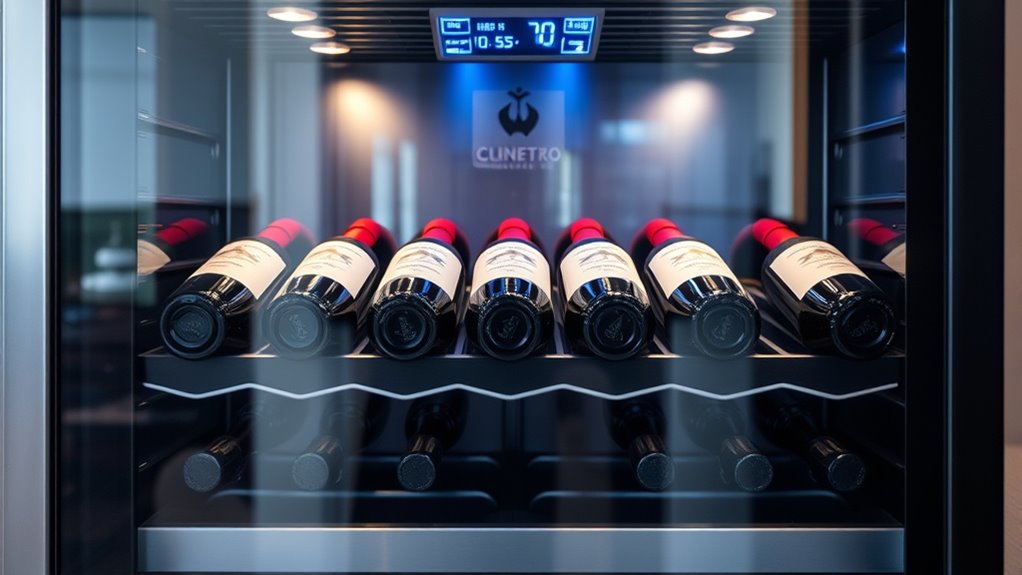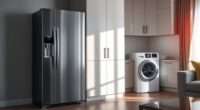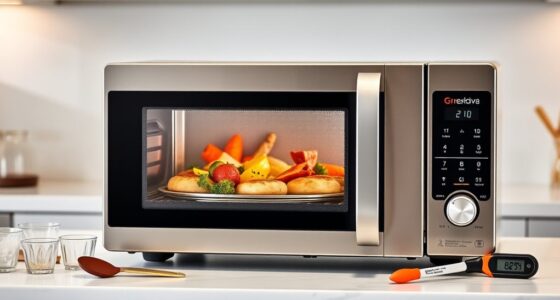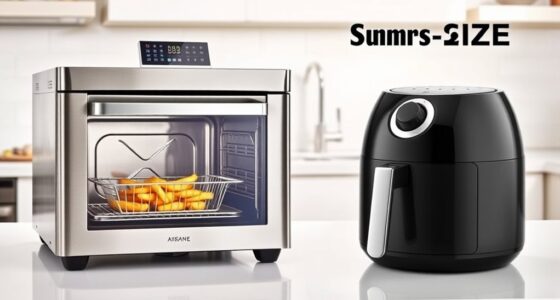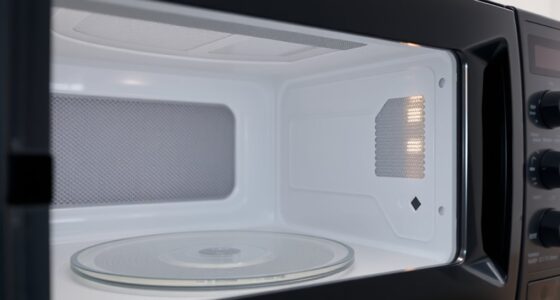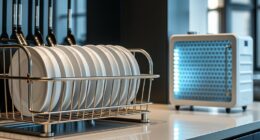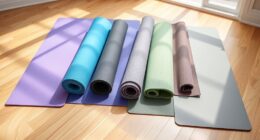Vibrations in your wine fridge can speed up chemical reactions, causing flavors to spoil and aromas to dull. They disturb sediment, alter color, and increase oxidation, all of which weakens your wine’s aging process. Proper vibration control keeps bottles stable, ensuring consistent maturation and preserving quality over time. If you want to understand how to create a peaceful environment that protects your wine’s development, explore the key features and placement tips that make a difference.
Key Takeaways
- Vibrations accelerate chemical reactions, leading to faster oxidation and degradation of wine quality.
- They disturb sediment and cloudiness, negatively affecting clarity and visual appeal.
- Vibrations weaken acids, tannins, and phenolic compounds, reducing flavor complexity and aroma intensity.
- Continuous vibrations can impair the aging process, resulting in less developed and less balanced wines.
- Using vibration-dampening features in wine fridges preserves wine integrity and prolongs optimal aging conditions.
How Vibrations Affect Wine Molecules and Aging Processes
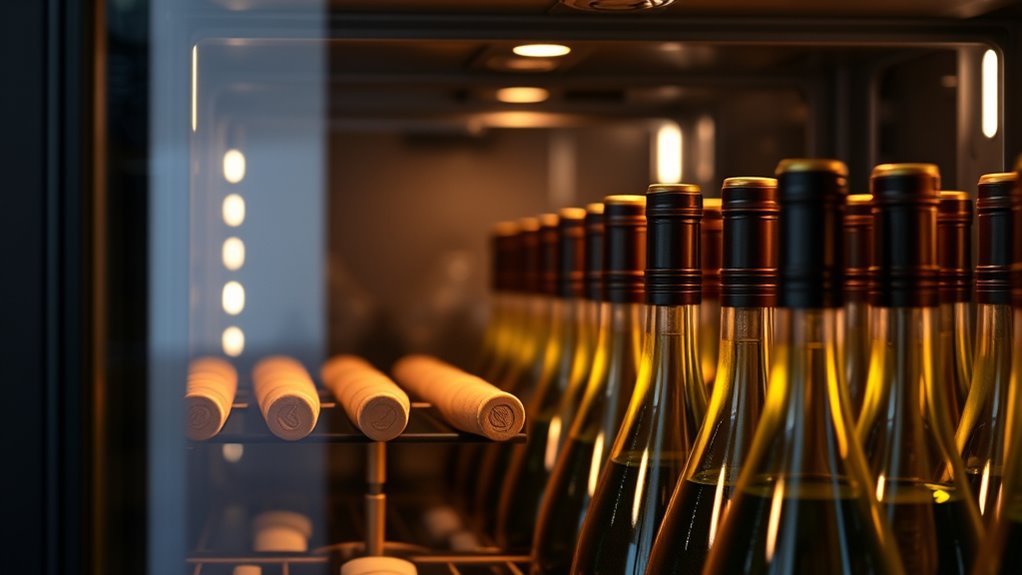
Vibrations directly influence the chemical stability and aging processes of wine by accelerating molecular changes. When exposed to vibrations, organic acids and tannins—crucial for wine’s structure and flavor stability—decline faster. You’ll notice reductions in key alcohols like propyl and isoamyl alcohol, which alters the wine’s aromatic profile. Vibrations also promote oxygen absorption, speeding up oxidation and changing aldehyde levels, such as furfural, which impacts aroma. Sulfur dioxide, an essential preservative, degrades more quickly in vibrated bottles, especially when stored horizontally. The amount of headspace and cork contact area further influence oxygen dissolution during vibration, affecting molecular aging pathways. Research shows that vibrations can also influence the solubility of phenolic compounds, altering color and taste. Additionally, temperature stability plays a crucial role in how vibrations impact wine aging, as fluctuations can exacerbate molecular reactions. Changes in storage conditions, like humidity and temperature, can further magnify the effects of vibrations on wine’s chemical composition. Overall, vibrations can hasten chemical reactions that define wine’s evolution, sometimes leading to premature aging or flavor loss.
The Role of Vibration in Sediment Resuspension and Flavor Alteration

Vibration keeps sediment from settling at the bottom of your wine bottles, which can lead to cloudy wine and altered flavors. When sediments resuspend, they disturb the delicate chemical balance, affecting aroma and taste. Over time, this constant agitation can also accelerate aging processes, changing how your wine develops. Embracing home decor principles and implementing vibration control measures in your storage environment can actually promote more consistent aging and preserve the wine’s intended profile.
Sediment Disruption Effects
When vibrations disturb the sediment settled at the bottom of a wine bottle, they prevent the particles from remaining undisturbed, causing them to resuspend into the liquid. This resuspension can lead to several issues. It decreases the wine’s clarity, making it appear murkier and less appealing. The suspended sediment interferes with aroma release, dulling the bouquet and altering flavor perception. Chemical stability also suffers, as agitation accelerates reactions, potentially increasing undesirable compounds like acetone. Additionally, sediment disturbance can cause uneven aging, resulting in inconsistent taste profiles. Proper vibration control can help maintain sediment stability and preserve wine quality. Controlling vibrations also supports the aging process, ensuring that wine develops its intended character over time.
Flavor Profile Changes
Have you ever considered how subtle movements can influence the delicate balance of a wine’s flavor profile? Vibration can alter chemical compounds, affecting taste and aroma. It stimulates reactions that change tartaric and succinic acids, key to complexity, and increases compounds like propanol and acetone, which dull aroma. Microvibrations cause shifts in volatile and phenolic profiles over time, leading to dull flavors and aroma loss. Sediment resuspension introduces bitter or earthy notes, disrupting the wine’s purity. Additionally, vibrations may compromise cork seals, speeding up oxidation and altering flavor. Electric power generation from bike generators demonstrates how vibrations can produce energy, highlighting their potential impact on delicate substances like wine. Here’s a visual overview:
| Effect | Result |
|---|---|
| Chemical reactions | Changes in acids and aromatic compounds |
| Sediment disturbance | Off-flavors and muted aromas |
| Microvibrations | Accelerated flavor degradation |
| Sediment suspension | Increased bitterness and imbalance |
| Seal compromise | Faster oxidation, flavor loss |
Furthermore, consistent vibration exposure can weaken cork seals, increasing the risk of spoilage.
Aging Process Impact
Sediments that have settled in wine can be easily resuspended by even minor vibrations, leading to increased cloudiness and altered clarity. This disturbance can affect the wine’s aging trajectory by changing its chemical makeup and visual appeal. Microvibrations promote sediment suspension, which can interfere with filtration and stability. Vibration accelerates acid degradation, influencing acidity levels and potentially shortening the wine’s shelf life. It also boosts oxygen dissolution, speeding up oxidation and SO2 loss, risking spoilage. Moreover, vibrations alter aromatic compounds, reducing complexity and producing off-flavors. The combined effects can cause wines to mature prematurely or degrade faster than intended.
- Resuspended sediments impact clarity and stability
- Accelerated acid and chemical changes mimic aging
- Increased oxidation risks spoilage
- Aromatic profiles diminish or shift unexpectedly
- Overall, vibrations can undermine the wine’s aging process
Key Features of Wine Fridges That Minimize Vibration Impact

You’ll want a wine fridge that features vibration-absorbing shelves and low-noise components to protect your wine’s quality. These features work together to minimize movement and mechanical noise, ensuring your bottles stay undisturbed. By choosing a fridge with these key elements, you help preserve your wine’s flavor and sediment stability. Additionally, vibration control technology can further enhance the stability of internal conditions, safeguarding your wine during storage. Finally, Halloween-themed decorations can enhance the ambiance without compromising the fridge’s stability.
Vibration-Absorbing Shelves
Vibration-absorbing shelves are essential components in wine fridges designed to protect delicate wines from disturbances. They help minimize vibrations that can disturb wine sediments and accelerate oxidation, preserving your wine’s integrity. Wooden shelves, especially beech and sapele, naturally dampen vibrations, with sapele offering superior durability and vibration resistance. Some fridges incorporate anti-vibration padding or linings directly into the shelves, further reducing transmission. High-end models feature shock absorbers or rubber mounts to isolate vibrations from compressors or other mechanical parts. Configurable shelving arrangements also help maximize space and vibration control, allowing you to position bottles for maximum protection. Proper shelf design and materials work together to ensure your wines age gracefully, maintaining their flavor and quality over time.
- Beech and sapele wood shelves for vibration absorption
- Anti-vibration padding or linings integrated into shelves
- Shock absorbers or rubber mounts for mechanical isolation
- Adjustable shelving for ideal placement
- High-tech specialized supports for added protection
Low-Noise Mechanical Components
Low-noise mechanical components are essential for minimizing vibrations in wine fridges, ensuring your wines remain undisturbed during storage. Thermoelectric cooling systems operate quietly because they lack moving parts, reducing internal vibrations. Compressor-based systems offer better temperature control but tend to produce more vibration, so vibration control features are necessary. Variable-speed fans adjust their speed based on cooling needs, decreasing constant vibration. Ducted systems isolate compressor and fan noise away from the wine storage area. Rubber or elastomer mounts on compressors and fans absorb vibrations before they transfer to the fridge structure. Specialized compressors with low decibel levels, vibration-dampening mounts, and integrated insulation further reduce mechanical noise and shake. These components work together to maintain a stable environment, protecting your wines during aging.
The Importance of Stable Temperature and Humidity in Wine Storage

Maintaining stable temperature and humidity is essential for preserving wine’s quality and ensuring proper aging. Fluctuations can stress corks, accelerate aging, or cause spoilage. Keep your storage environment within the ideal range—around 55°F (13°C)—and aim for humidity levels near 60%. This prevents corks from drying out or swelling, which can compromise the seal. Consistent conditions reduce chemical instability, preserving flavors and aromas over time. External factors like sunlight, drafts, and temperature spikes should be avoided. Use insulated storage, vapor barriers, and controlled airflow to maintain stability. Regularly monitor temperature and humidity with reliable tools. Proper environmental control helps your wine age gracefully, maintaining its integrity and value. Effective environmental management is also key to preventing unwanted vibrations that can disturb sediment and affect aging. Additionally, understanding angel number signals related to love and connection can remind you of the importance of harmony not only in relationships but also in your storage environment.
How Proper Placement Enhances Vibration Protection

Placing your wine fridge away from sources like washing machines or heavy machinery helps reduce vibrations that can disturb your wine. Make sure it sits on a solid, stable surface rather than thin or uneven floors, which transmit more movement. Using vibration dampening pads can further protect your bottles from subtle environmental vibrations. Additionally, understanding AI’s role in cybersecurity highlights the importance of safeguarding your appliance against potential digital vulnerabilities that could affect its operation. Recognizing sustainable appliance use can also promote energy-efficient and environmentally conscious practices in your wine storage.
Position Away From Vibrations
Proper placement of your wine fridge away from vibration sources is essential to protect the delicate sediment and guarantee ideal aging. When your fridge is positioned near heavy machinery, train lines, or household activities like jumping on trampolines, vibrations can disturb the wine’s natural settling process. Placing it away from vibrating walls, floors, or shared walls with appliances reduces the risk of molecular disturbance. Keep it in low-traffic areas or corners with less footfall to minimize impact shocks. Additionally, considering the regional culture of the area can influence the selection of quieter, less active locations for your wine storage. Using vibration protection methods, such as vibration isolation pads or thick mats underneath the fridge, further enhances stability and preserves wine quality. Avoid areas near HVAC units or compressors, and keep the fridge away from stairs or foot traffic zones. Select spots with minimal household activity and position in dedicated wine storage spaces for stability.
Choose Stable Surfaces
Choosing a stable surface is essential for minimizing vibrations that can harm your wine during aging. A solid, level foundation prevents uneven vibrations, reducing noise and protecting sediment stability. Use leveling tools or adjustable feet to ensure your fridge sits flat. Placing it on hard, dense surfaces like tile or concrete absorbs vibrations better than soft or uneven flooring. Rubber or silicone pads further dampen vibrations, creating a more stable environment. Additionally, selecting a surface with good vibration absorption properties can significantly enhance your wine’s aging process. Ensuring the proper placement of your fridge not only improves stability but also contributes to the overall quality of your wine over time.
Benefits of Vibration-Controlled Storage for Wine Quality and Value
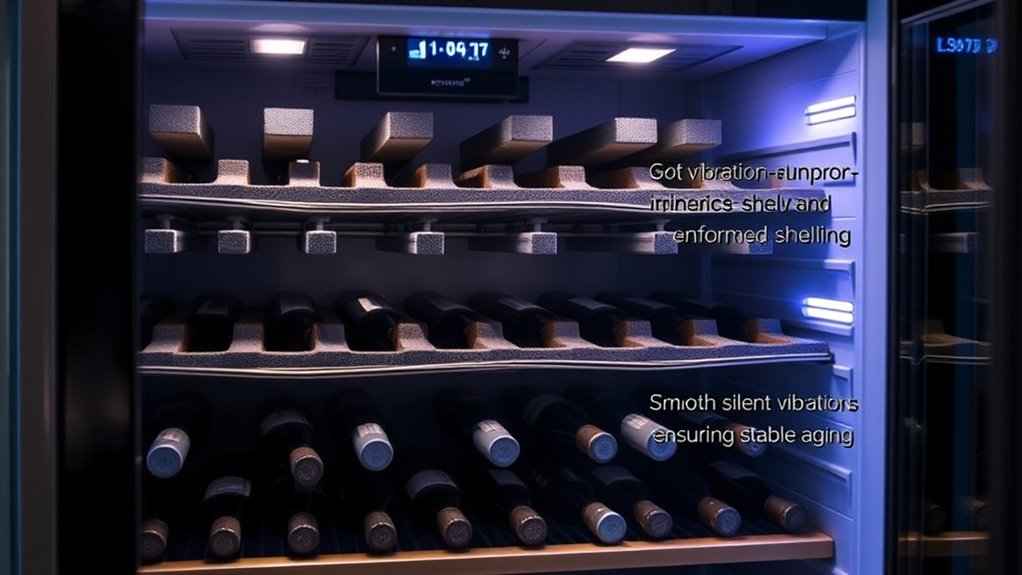
Vibration-controlled storage plays a crucial role in maintaining your wine’s quality and value by preventing disruptions to its delicate chemical balance. When vibrations excite wine molecules, they cause premature aging, spoilage, and flavor loss. Sediments in red wines can re-mix into the liquid, dulling aromas and altering taste. By minimizing micro-movements, you preserve the wine’s intended maturation, ensuring its bouquet, taste, and texture stay intact. Proper vibration control also helps maintain clarity, especially in older or unfiltered wines, and prevents gritty textures caused by unsettled sediments. Additionally, stable environments slow unwanted chemical reactions, supporting graceful aging. Incorporating smart IoT technologies in wine storage systems can further optimize vibration levels and environmental conditions. Understanding the importance of vibration in wine aging can help enthusiasts make informed choices about storage solutions. Overall, vibration-controlled storage safeguards your investment, keeps wines tasting their best, and preserves their long-term value and appeal.
External Sources of Vibration and Their Risks to Wine Cellars
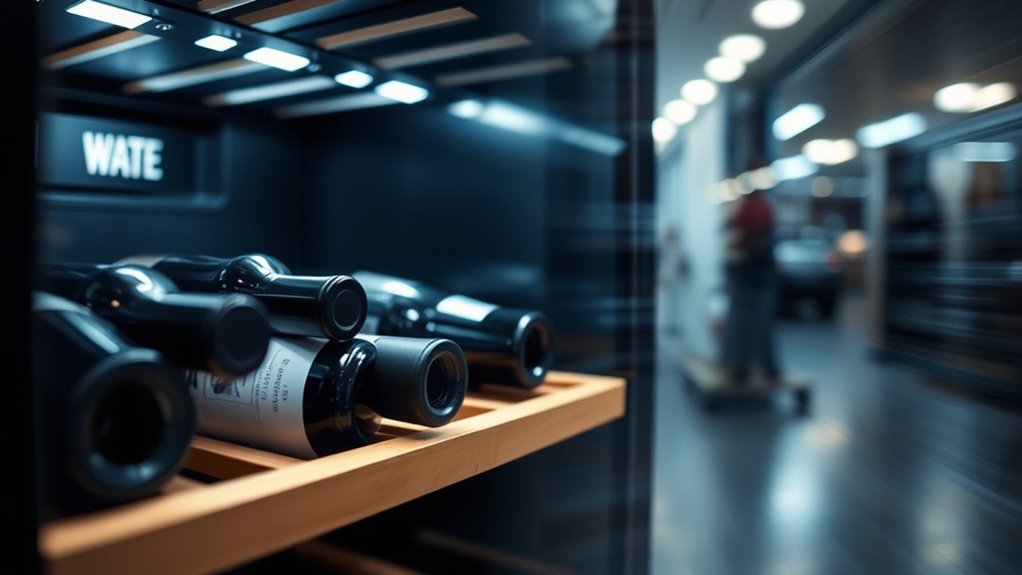
External vibrations from nearby sources can pose significant risks to your wine cellar’s delicate environment. Domestic appliances like washing machines and dryers produce continuous low-frequency vibrations that can disturb sediment and accelerate aging issues. HVAC systems generate mechanical vibrations transmitted through building structures, while nearby traffic and heavy vehicles cause ground-borne vibrations that shake bottles and disrupt sediment layers. Urban vibrations from underground trains or metro lines can also penetrate foundations, leading to micro-movements in your storage. Additionally, building maintenance activities such as elevator operation or construction create intermittent vibration spikes. These external sources can cause sediment disturbance, chemical reaction acceleration, cork loosening, and even microfractures in bottles. To protect your wine, it’s essential to locate your cellar away from these vibration sources and incorporate vibration-dampening measures. Understanding architectural solutions can further aid in designing spaces that minimize transmission of external vibrations, including specialized isolation techniques to absorb and reduce vibrations before they reach your wine.
Technologies and Certifications Ensuring Vibration Dampening in Wine Fridges

Modern wine fridges incorporate advanced technologies and certifications to guarantee effective vibration dampening, protecting your wine from disturbances that can compromise its quality. These innovations include systems like Tru-Vino and PreciseTemp, which regulate temperature while minimizing vibrations. Certifications such as energy efficiency, seismic testing, and ISO standards ensure models meet strict vibration control criteria. Some fridges feature specialized vibration-dampening systems or advanced materials designed to reduce vibrations further. Additionally, noise reduction standards often reflect effective vibration management. These certifications and technologies work together to maintain a stable environment, ensuring your wine ages gracefully. Proper asset division strategies can also play a role in safeguarding valuable wine collections during legal proceedings.
Modern wine fridges use advanced tech and certifications to minimize vibrations and protect wine quality.
- Vibration-dampening materials like rubber shock pads absorb compressor vibrations
- Secure compressor mounting prevents vibration transmission
- Integrated fans ensure even temperature without causing vibrations
- Design features that keep bottles undisturbed, mimicking static conditions
- Vibration control systems in premium models for enhanced protection
Long-Term Effects of Vibrations on Wine Development and Complexity

Vibrations can considerably influence how wine develops over time, affecting its acidity, clarity, and overall complexity. They speed up acid reduction, especially tartaric acid, compressing years of aging into months. Vibrations also cause cloudiness, alter color, and increase refractive index, reducing visual appeal. Chemically, they weaken acids, tannins, and alcohols, and promote oxygen absorption, accelerating oxidation. Sensory attributes change, impacting aroma, flavor, and overall quality, often reducing complexity. Moderate vibrations might temporarily preserve or enhance certain qualities, but prolonged exposure risks degrading the wine’s structure. To illustrate, consider the following:
| Effect | Impact | Result |
|---|---|---|
| Acid Content Changes | Accelerated tartaric acid reduction | Faster aging process |
| Clarity and Appearance | Increased cloudiness | Lower visual quality |
| Chemical Composition | Faster phenolic and tannin decline | Reduced complexity and flavor |
Tips for Creating a Vibration-Resistant Environment at Home

Creating a vibration-resistant environment at home starts with identifying and evaluating potential sources of disturbance. You need to pinpoint vibrations from HVAC systems, elevators, traffic, and nearby construction. Household appliances like washing machines, tumble dryers, and compressors can also cause microvibrations that affect your wine. External factors like underground trains or children playing may introduce subtle shakes, so monitoring is essential. To minimize these issues, consider implementing structural and environmental control measures.
- Install vibration-dampening flooring materials
- Use specialized wall-mounted racks with isolation systems
- Add padding around shelves and floors
- Position your wine fridge low to the ground
- Keep storage inside secured crates or boxes
These steps will help create a stable environment, preserving your wine’s aging potential.
Frequently Asked Questions
How Does Vibration Specifically Accelerate Wine Aging?
Vibration accelerates wine aging by speeding up chemical reactions like oxidation and acid breakdown, which normally take years. It disturbs sediment, mixes particles, and promotes reactions that alter flavor, aroma, and color. The constant energy from vibration increases oxygen absorption and degrades phenolic compounds, leading to duller taste and less stability. This process shortens aging time but can compromise overall wine quality and sensory characteristics.
Can Vibrations Damage Wine Bottles Even Without Physical Movement?
Yes, vibrations can damage wine bottles even without visible movement. When vibrations occur, they create kinetic energy inside the bottle, triggering chemical reactions that can alter the wine’s aging process. This can reduce key acids, dull flavors, and cause off-odors. Even subtle vibrations disturb sediment settling and accelerate premature aging, especially in delicate or older wines. To protect your wine, keep bottles in a stable, vibration-free environment.
Are All Wine Fridges Equally Effective at Reducing Vibrations?
Not all wine fridges are created equal in their fight against vibrations. Some are like tranquil lakes, whisper-quiet with advanced insulation and vibration dampening, while others are turbulent streams, rattling and humming with weaker compressors. You need to look beyond the surface—check the technology, design features, and user reviews. The better the vibration control, the more your wine can age gracefully without disturbance, preserving its delicate character.
What Are the Best Placement Strategies to Minimize Vibration Exposure?
You should place your wine fridge away from heavy appliances, transit routes, and areas with frequent movement. Use vibration dampening supports like rubber mats or anti-vibration feet, and choose models with low-vibration technology. Position bottles securely and away from door areas, keeping heavier bottles lower. Guarantee the fridge is on a stable, sturdy surface, and regularly check damping materials to keep vibrations minimal, protecting your wine’s quality.
How Do Vibration Controls Compare Between Different Wine Fridge Models?
You’ll notice some wine fridges are like a whispering breeze, barely a vibration, while others shake your bottles like an earthquake. Models with vibration dampening, compressor isolation, and advanced shelving reduce motion to nearly zero. Thermoelectric units are silent and vibration-free but limited in size. High-end brands like Zephyr and Liebherr excel, offering ultra-stable environments, ensuring your wine ages perfectly without a single tremor disturbing its delicate sediments.
Conclusion
Think of your wine as a delicate dance partner; even small vibrations can throw off its rhythm and prevent it from maturing gracefully. By choosing the right fridge, placing it carefully, and considering external influences, you create a sanctuary where your wine can develop its full complexity. Protecting it from vibrations is like giving your wine a gentle lullaby—allowing it to age beautifully, just as nature intended.
